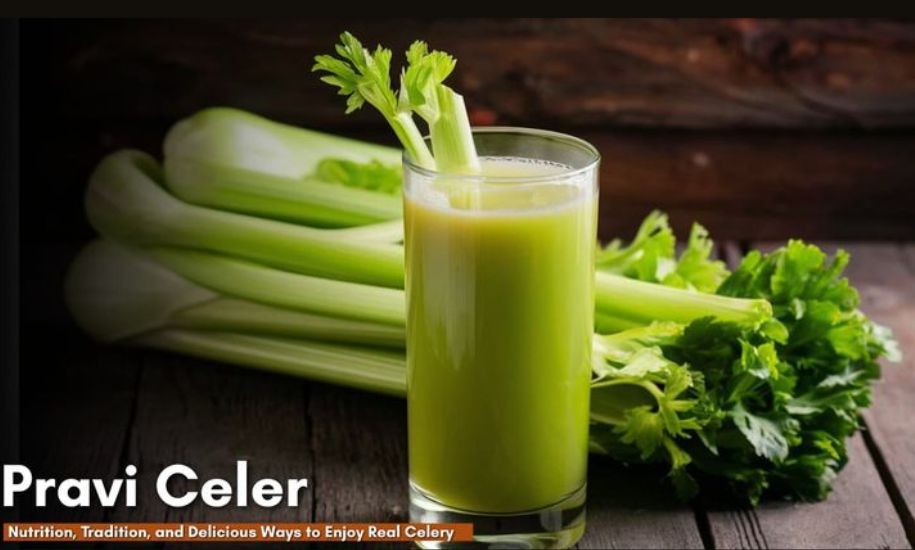In the colorful tapestry of vegetables, few are as underappreciated yet versatile as pravi celer — literally “true celery.” While most people think of the crisp stalks in salads or the garnish in soups, pravi celer encompasses the broader, more traditional forms of celery: stalk celery, leaf celery, and especially the root form known as celeriac. In Balkan and Central European cuisines, “pravi celer” evokes a sense of authenticity — the original, unadulterated celery in its many delicious manifestations. In this article, we explore its botany, nutrition, culinary roles, cultivation tips, caveats, and ideas for using it in your kitchen and diet.
What Is “Pravi Celer”?
“Pravi celer” is a phrase used in several Slavic languages (Croatian, Serbian, Bosnian, etc.) to denote “real celery.” The term is broadly applied to the species Apium graveolens, which has a few cultivars and growth forms:
- Stalk celery (Apium graveolens var. dulce): This is what many people in the West call “celery” — with long fibrous stalks and leafy tops, used raw in salads, as a snack, or in soups and stews.
- Leaf celery (Apium graveolens var. secalinum or crispum): More leafy and aromatic; its leaves and thinner stalks are used as an herb or seasoning.
- Root celery / celeriac (Apium graveolens var. rapaceum): Grown for its swollen, bulbous taproot. This is often the heart of “pravi celer” in Balkan cooking: it is grated, cooked, or pureed.
So, when someone refers to pravi celer, they may be pointing to any of these, or a combination, but with an emphasis on traditional, authentic celery rather than some modern hybrid.
From a botanical point of view, Apium graveolens is in the family Apiaceae (the carrot / parsley family). It thrives in temperate climates, often as a biennial, with a hollow stalk and pinnate leaves. The root form (celeriac) can develop a large edible root with a rough exterior and creamy interior.
Nutrition & Health Perspective
Before we dive into claims, it’s vital to emphasize: this is not medical advice. The role of celery or celeriac is as a nutritious food, not a cure-all. Here’s a breakdown based on common data compiled by nutrition analysts and food blogs:
Macronutrients & Calories
Pravi celer is low in calories but offers dietary fiber, which helps digestive regularity. The stalk variety is particularly low in carbs; celeriac, being more root-like, has slightly higher carbs but still moderate compared to potatoes or carrots.
Micronutrients
Celery (and celeriac) supplies:
- Vitamin K — important for normal blood clotting.
- Folate (B9) — beneficial for cell growth and repair.
- Potassium — helps with electrolyte balance.
- Vitamin C and small amounts of vitamin A and magnesium — in lesser amounts but contributing to overall intake.
Phytochemicals & Antioxidants
Celery contains flavonoids and phenolic compounds (e.g. apigenin) that are often discussed in wellness blogs. These compounds are thought to provide anti-oxidative effects (neutralizing some reactive oxygen species). However, their real-world effect in humans is nuanced and depends on overall diet.
Hydration & Fiber
Because the stalks are ~95% water, they help with hydration. The fiber content (especially insoluble fiber) encourages gut motility. Some blogs promote celery juice or water-rich celeriac preparations, but it’s wise to balance juices with whole food for fiber.
Moderation & Cautions
- Individuals with kidney issues may need to watch potassium-rich foods (celery contributes but is not especially high compared to bananas).
- Overemphasis on celery juice alone (to the exclusion of other foods) is not a balanced approach.
- Allergies: like many Apiaceae plants, celery can cause sensitivities in some people (especially those with pollen–food syndrome).
- Because of water content, fresh celery may deteriorate in storage; older stalks get stringy.
Culinary Uses & Recipes
One of the greatest strengths of pravi celer is how many ways you can use it. Below are classic and creative uses.
Balkan / Regional Classics
- Celeriac / root-celery salad: One of the signature “pravi celer” uses. The root is peeled, shredded or grated, then mixed with sour cream, mayonnaise, sometimes yogurt, garlic, walnuts or cheese. The result is crunchy, creamy, and slightly tangy.
- Celeriac mash or purée: cooked root celery mashed with butter, cream or milk, often paired with potato or parsnip.
- Soup & cream soups: Puree celeriac into a silky soup (often with onions, broth, and a little cream).
- Roasted celeriac slices (“steaks”): cut the root into thick slices, season with herbs/oil, roast until golden.
- Stalk celery in stews/juices/salads: The stalks and leaves are aromatic and often added early in broths or stews. In chopped form, stalk celery adds crunch to raw salads.
Modern & Fusion Ideas
- Celeriac fries / chips: Cut root celery into sticks or thin slices, toss in olive oil and spices, roast or bake until crisp.
- Celery-leaf pesto / sauce: Use the leaves (which are often discarded) blended with nuts, olive oil, garlic, and cheese.
- Celery smoothie blends: Combine stalk celery with green fruits and vegetables. To preserve fiber, use whole stalks rather than juices alone.
- Stuffed celery stalks: Fill with cheese spreads, nut butters, or hummus — a low-carb snack.
- Grilled celery hearts: Brush the inner cores with oil, grill lightly until tender with grill marks.
Tips for Flavor & Texture
- Peel thick roots (celeriac) before shredding; outer skin is fibrous.
- Use a sharp grater or mandoline for consistent pieces.
- Toss shredded root immediately in lemon or mild acid to prevent browning.
- When using stalk celery raw, choose the inner stalks (less stringy).
- Salt generously in cooking — celery has natural saltiness but benefits from seasoning to bring its flavors out.
Cultivation, Seasonality & Storage
Adding a bit of gardening or produce lore gives depth to your article.
Climate & Soil
Pravi celer thrives in cool, moist climates. It prefers rich, well-drained soil high in organic matter, with consistent moisture. Clay soils are acceptable if tilled well. Avoid extreme heat or drought stress (which leads to stringiness or pithy texture).
Planting & Timing
- Starting seeds indoors: Many gardeners begin celery seeds indoors 8–10 weeks before the last frost date, then transplant after risk of frost passes.
- Spacing: Plants spaced roughly 20–30 cm apart give room for stem expansion or healthy roots.
- Succession planting: Especially when growing the root form, you may plant at intervals so you can harvest over a season.
Maintenance
- Regular watering: Keep soil evenly moist.
- Mulching: Helps conserve moisture and suppress weeds.
- Fertilizing: A balanced fertilizer or compost tea can boost growth, especially nitrogen early on.
- Blanching (for stalk celery): Some traditions mound soil or use covers to “blanch” lower stalks for tenderness (less bitter).
Harvest & Season
- Stalk celery: Harvest stalks as needed, often before flowering.
- Celeriac / root celery: Typically ready in 100–120 days; harvest before hard frost (but in cool weather).
- Storage:
• Stalk celery can be stored upright in water or wrapped in damp paper in the fridge (1–2 weeks).
• Celeriac roots can last several weeks in cool, humid root-cellar conditions or in perforated plastic in fridge (~4–6 °C, ~90% humidity).
Selling, Selecting & Buying
For readers who might not grow their own, advise on what to look for and how to care for purchased celer.
Choosing good specimens
- Stalk celery: Firm, crisp stalks that snap; uniform pale or light green (depending on variety); minimal browning at ends.
- Celeriac / root: Solid, heavy for size, smooth skin with few cracks; avoid roots that are soft, moldy, or excessively spongy.
Storage & Use
- Refrigerate quickly after purchase.
- Trim and wrap: Remove tough outer layers and wrap roots or stalks.
- Freeze options: Blanch then freeze celery in cubes, though texture will decline.
- First use fresh: Use tender inner parts for raw dishes; tougher parts can go to cooking.
Common Myths, Trends & Skepticism
Because “pravi celer” sounds traditional and perhaps “superfood-like,” it attracts claims and fads. Here’s a balanced perspective:
“Miracle cure” claims
Some blogs or social media promote celery juice as a detox elixir, cure for chronic ailments, or weight-loss magic. While celery has healthful properties, it is not a panacea. Emphasize in your article: whole diet matters more than any single food.
Overconsumption risks
Excessive intake of highly concentrated drinks (celery-only juices) may lead to electrolyte imbalances or nutrient imbalances. A mixed diet is safer.
Texture and flavor missteps
Because celery has high water content, expecting it to behave like a potato or carrot in all recipes will fail — texts should warn readers not to overcook or expect the same firmness. Also, pairing celery with robust flavors (e.g. garlic, cheese, herbs) often gives it the boost it needs.
Culinary Inspiration: Sample Menu
Here’s a small sample menu built around pravi celer to show readers how to weave it into a full meal:
- Starter: Celery leaf pesto crostini
- Soup course: Cream of celeriac & potato soup
- Main side: Roasted celeriac “steak” with herbs
- Salad: Grated celeriac salad with apple, walnut & yogurt dressing
- Snack: Stuffed celery stalks with herbed cream cheese
- Dessert (bonus): crisp celery chips sprinkled with sea salt
This menu shows the breadth — from raw to cooked to snackable — reinforcing celery’s versatility.
Conclusion & Final Thoughts
Pravi celer may not always command the spotlight in produce aisles, but its depth of flavor, adaptability, and nutritious profile make it a hidden gem. Whether you favor the crispness of stalk celery or the earthy creaminess of celeriac, this “true celery” deserves a place in your kitchen and your imagination. Use it raw, roast it, mash it, or juice it — always with respect to balance and variety in your diet.
If you explore authentic Balkan or Mediterranean cooking traditions, pravi celer is indispensable. Let your readers see it as both tradition and possibility.
Thank you for reading — I hope this detailed portrait of pravi celer enriches your knowledge and inspires your cooking. This article is brought to you by Buz Vista.

